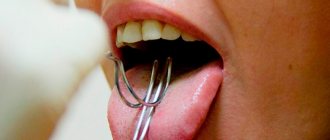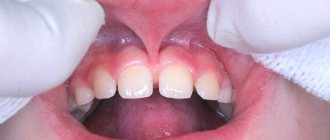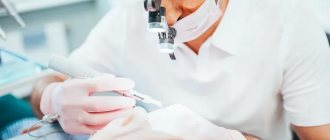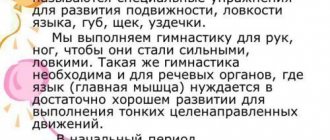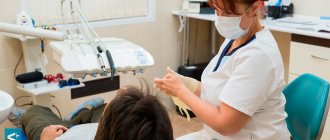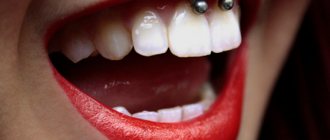The labial frenulum is a fold of mucous membrane (between the central incisors of the upper and lower teeth) that connects the lip and gum. It is involved in lip movement and articulation in speech. The health of the teeth, the correctness of the bite, the pronunciation of sounds, and the beauty of the smile depend on the quality and elasticity of the place where it is fixed to the gum.
The frenulum of the lip meets the gingival tissue at a distance of 5-8 mm from the necks of the anterior teeth. If it starts very close to the teeth, then it is considered to be shortened. It may also be that the frenulum is too wide. To avoid unpleasant consequences in the future or eliminate existing problems, doctors often recommend plastic surgery of the labial frenulum.
What is dangerous about the pathology of the frenulum attachment?
Indications for frenuloplasty arise not because of doctors’ desire to correct an anatomical feature, but for compelling reasons that affect the health and beauty of the smile. A similar defect results in:
- to the formation of a diastema - an excess gap (gap) between the front incisors, which, moreover, tends to expand. A short frenulum is fixed too close to the edge of the alveolar process and pushes the teeth in different directions;
- the appearance of a gum pocket - a depression behind the gum due to its injury by the frenulum, where food debris begins to accumulate, tartar forms, and the exposed necks of the teeth suffer from increased sensitivity. Ultimately, this process can lead to periodontitis, loosening and loss of teeth;
- speech problems - with a short frenulum it is difficult to pronounce many consonants and some vowels (“o”, “u”);
- bite pathologies - due to improper closure, tooth enamel is erased, teeth grow in the wrong direction, oral hygiene, the quality of chewing food and the functioning of the entire gastrointestinal tract deteriorate, and at the same time, a short frenulum prevents the correct installation of the braces system;
- difficulties when performing prosthetics - a short frenulum does not allow the prosthesis to be firmly held in the mouth, and it may fall out while eating or talking;
- injury during individual oral hygiene and its deterioration in general.
Symptoms of gum inflammation
According to statistics, more than 70% of people have experienced inflammation of the gums between their front teeth at least once in their lives. The main signs of the problem include:
- redness of the gingival papilla,
- swelling of soft tissues,
- bleeding gums,
- bad breath,
- accumulation of pus in the interdental space,
- discomfort when brushing teeth and eating.
If you notice any of these signs, you should consult your doctor. These symptoms can indicate either injury to the gums from hard food or bones, or the development of serious diseases.
Are there any contraindications?
When deciding whether to undergo lip frenuloplasty, the doctor will definitely assess the risks and check for contraindications. There are few of them, since the operation is considered minimally invasive:
- recurrent pathologies of the oral mucosa;
- tendency to develop keloid scars;
- bleeding disorders;
- inflammatory diseases of the jaws;
- decompensated forms of chronic systemic diseases;
- general disorders - mental disorders, cerebral pathologies, oncological processes, exacerbations of chronic diseases.
When to see a doctor?
Most people can treat a frenulum tear at home. However, in some situations a doctor may be required.
A person should see a doctor within 24 hours if the injury appears infected but there is no fever.
You should consult a doctor immediately if the following symptoms appear:
- a deep tear that may require stitches;
- severe pain that lasts for several hours;
- difficulty swallowing liquids, including saliva;
- problems with fully opening or closing the mouth;
- increased pain or swelling after 48 hours;
- heat.
If you find an error, please select a piece of text and press Ctrl+Enter.
When to perform the operation?
It is best to perform the operation on children aged 5 to 8 years during the period when baby teeth are replaced by permanent teeth. The most appropriate moment is when the lateral incisors (“twos”) have not yet erupted, and the central ones have appeared by about a third. Plastic surgery will prevent the development of diastema and will help the incisors to take a central place.
The operation can be performed on both adolescents and adults. Plastic surgery of the frenulum of the upper lip in infants is performed only according to strict indications that affect the quality of the child’s nutrition.
In adulthood, surgery most likely will not solve the problem, but it will greatly facilitate the process of prosthetics.
Indications for labial frenuloplasty
Normally, the frenulum does not interfere with a person in any way, but in some cases it can cause significant discomfort. Due to certain physiological characteristics, it can interfere with normal speech, negatively affect teeth and cause malocclusion. In such cases, surgery is necessary.
If there are abnormalities in the attachment of the frenulum to the upper or lower lip, surgical plastic surgery is indicated. Indications for surgery may be:
- formation of a diastema (gap between the front teeth);
- disorders of chewing functions;
- inflammation of the gums;
- periodontal diseases;
- dysfunction of sucking in infants;
- speech defects in children, etc.
Upper lip frenuloplasty is also performed for hygienic reasons. A wide frenulum leads to a systematic accumulation of deposits between the teeth. As a result, plaque forms on the surface of the incisors, and then tartar. All this can cause the development of caries and inflammation of soft tissues.
Another common complication that accompanies an incorrect frenulum is the development of tooth instability and increased sensitivity. A wide frenulum leads to exposure of the roots of the teeth, which significantly reduces overall immunity in the oral cavity. Bacteria and infections easily penetrate the gums, which leads to various periodontal diseases.
A short frenulum interferes with normal speech. The operation must be carried out for freer movement of the tongue and lips, without which the development of correct diction is impossible. The decision to correct the frenulum in this case is made by a speech therapist.
Indications for plastic surgery are determined by the following specialists:
- orthodontist;
- neonatologist;
- speech therapist,
- periodontist.
Plastic surgery to correct the frenulum of the upper lip should be performed in childhood. The most optimal age is 7-8 years (after complete eruption of the upper incisors). Advanced anomalies, such as an overly wide frenulum, can lead to serious consequences that can only be eliminated with long-term orthodontic treatment.
How is the operation performed?
During a frenuloplasty operation, depending on the type of its structure, the surgeon cuts the fold, excises excess tissue or moves the point of its attachment to the gum. The procedure is performed under local anesthesia, is absolutely painless and lasts no more than 10-15 minutes.
At the IONIKA clinic, doctors are equally proficient in both methods of frenuloplasty - laser and scalpel. Each technique has its own strict indications, its advantages and disadvantages. Despite the fact that laser plastic surgery of the upper lip frenulum has gained the greatest popularity today, we sensibly assess each clinical situation and choose the optimal way to solve the problem based on the patient’s characteristics.
- Laser . This is a minimally invasive method in which a laser beam “dissolves” the frenulum or removes excess tissue, immediately sealing the edges of the wound. The operation is completely bloodless, without the need for stitches, and rehabilitation takes a minimum of time. Laser plastic surgery of the lower lip frenulum is most often used when working with young patients.
- With a scalpel . The classical method is also low-traumatic and is supplemented only by suturing. It is used, as a rule, in cases with a thickened frenulum.
Preparation and Execution
Any surgical intervention requires some preliminary preparation. Correction of the frenulum is no exception.
This procedure is performed on an outpatient basis. After 30-50 minutes, the patient can go home, where he must strictly follow the recommendations throughout the entire recovery period.
Checking for contraindications
To make sure there are no contraindications and reduce the risk of possible complications, the doctor asks the patient to take basic tests: fluorogram, general blood and urine tests, and a coagulation test. The permission of a dentist and therapist is also required.
Direct contraindications to the procedure are:
- active inflammatory processes in the body;
- caries, infectious or fungal diseases in the oral cavity;
- blood diseases and blood clotting disorders;
- epilepsy and serious mental disorders;
- exacerbation of chronic ailments;
- active form of the herpes virus;
- tendency to form keloid scars;
- cancer and autoimmune diseases;
- recent radiation exposure in the head and neck area;
- severely reduced immunity for any reason.
For adult women, additional restrictions include pregnancy and breastfeeding. The procedure is not performed during menstruation, as well as 2-3 days before and after it.
Technique
There are several techniques for performing this operation. The doctor decides which one to choose.
The preference for one technique or another is not always based solely on the presence or absence of modern equipment. In some cases, a regular scalpel is much more convenient and effective than a laser one. Everything is strictly individual.
Plastic surgery of the frenulum of the upper lip with a laser does not require sutures, since the device allows the surgeon to act with the highest precision, “evaporating” sequentially, fractions of a millimeter, excess tissue.
The wound surface is immediately disinfected, small capillaries are sealed. Therefore, there is practically no blood loss.
Sometimes the bridle needs to be not just shortened, but moved. Then a regular scalpel is used to make a Y or Z-shaped incision. After correct installation, the bridle is secured with the finest suture material.
Healing in this case takes a little longer. At first after frenuloplasty, there may be a feeling of unpleasant tightness.
A frenulum that is too wide and short makes it impossible to properly care for the oral cavity. Plaque and decaying food debris accumulate on the teeth and gums. The skin fold becomes a source of infection, which can lead to inflammation and dental diseases.
To avoid such unpleasant consequences, a frenectomy is performed - partial or complete removal of tissue. It is done with a laser or scalpel.
Rehabilitation
As already mentioned, the operation is very easy. It takes no more than 15-20 minutes.
For the procedure, local anesthesia is sufficient. Immediately after the end of its action, mild pain or burning sensations may be observed for some time. Already on the second day, the discomfort usually goes away completely.
The mucous membrane heals quickly. The most important thing in the postoperative period is to prevent it from becoming irritated or infected.
To do this, you must follow these recommendations:
- do not eat or drink for 2-3 hours after the procedure;
- Do not eat anything too spicy, salty or hot for a week;
- brush your teeth very carefully so as not to damage the frenulum;
- Rinse your mouth with an antiseptic solution after each meal.
You should definitely see a doctor every other day. You need to make sure that the healing process is going well.
After a week, you can begin to perform special exercises to restore diction and develop facial muscles. Massage is also useful, eliminating tension and increasing the elasticity of soft tissues.
After 5-7 days, the person completely returns to his usual lifestyle. All restrictions are lifted.
How long will it take to heal?
After plastic surgery of the frenulum of the lower lip, the rehabilitation period takes up to two weeks, and the wound on the upper lip heals in just a few days. In the first case, anti-inflammatory treatment is often prescribed to ease the postoperative period and eliminate the risks of complications.
To avoid injury and the risk of infection, thorough but gentle oral hygiene twice a day is necessary. You should avoid hard and hot foods in your diet, and rinse your mouth after eating. Parents are advised to pay closer attention to the cleanliness of their child’s hands.
Return to list of articles
First aid for a ruptured upper frenulum
Upper frenulum ruptures are common in children. The main symptom is bleeding from the upper gums and lips.
These injuries rarely require treatment and heal without stitches.
First aid tips for a torn frenulum include:
- Press your outer lip against your teeth for 10 minutes to stop bleeding;
- do not pull out the lip to check the injury, as this may renew the bleeding.
Be sure to check for other signs of swelling or infection after 3 days. After this time there should be no bleeding.

